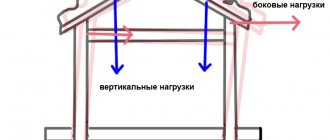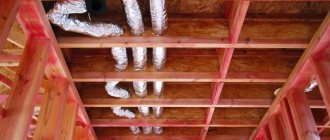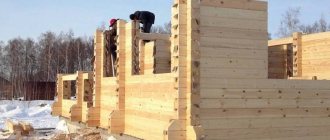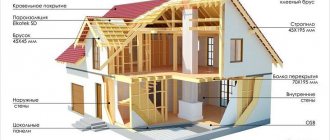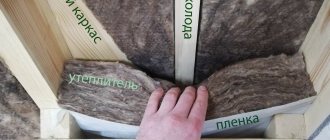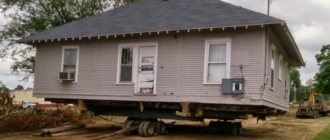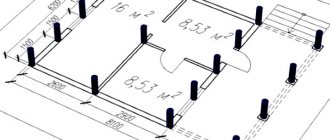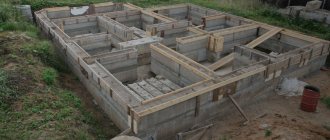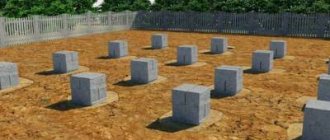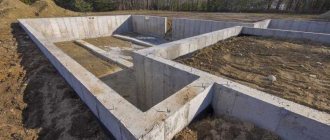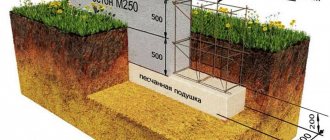Construction tools needed to build a frame house
This is the entire list of tools that I purchased (the most necessary tool is marked in bold, the rest are a matter of convenience): Planer Corded screwdriver Thicknesser Cordless screwdriver Circular saw 2 kW for the table Circular saw Jigsaw Hammers 3 pcs . Level Level 40 and 100 cm Nailers 2 pcs. and a bunch of adapters, extension cord, oil Metal scissors Foam gun Swanson square Regular square 35 cm Large square 120 cm Tape measures 5 pcs : 3 meters, 8 meters, 9 meters, 10 meters, 30 meters Hammer stapler and staples for it Electric drill Bits for screwdrivers 5 different packages and separate Ph2 and Pz2 - constantly running out and have already bought a hundred new ones Miter saw Clamps 8 pcs Compressor Construction pencils Construction knife Rule 2.5 meters Hydraulic level Hacksaw Construction lace and ink for it Frame framer belt Polypropylene twine 300 m
After some time, the following were added to this list:
Reciprocating saw Stairs Construction vacuum cleaner and much more that I will definitely add to the post as I remember. The list is constantly growing, despite the fact that these are seemingly the most necessary tools.
Great video about the tool:
And this is a video from the forumhouse on the topic of tools if you are building a frame house alone:
Don’t forget about the protective clothing that is needed for your safety. Safety precautions for a frame house require wearing (all are important): Noise headphones Shockproof boots Eye protection glasses (solid and regular) Work gloves Respirator and filters for it Safety ropes, carabiners, etc.
Rating of gas nailers
Gas guns can be used both in finishing and in construction. A comparison of nailers shows that, depending on the specific model, they can demonstrate good power.
SPIT Pulsa 800P+
The French-made functional nailer is equipped with a gas cylinder designed for 600 shots, while the operating speed of the device is two blows per second. The nailer's magazine is small, with only 20 elements, but if desired, it can be replaced with a more spacious one. The maximum length of fasteners is 40 mm.
Attention! The nailer supports the Start & Go energy saving function and turns off automatically after a minute of inactivity.
You can buy a SPIT nail gun from 82,000 rubles
Toua GSN F1
The gas nailer is suitable for working on steel and concrete surfaces. The cylinder capacity is enough for 1400 shots, the pistol is equipped with two barrels - for shallow depth and for maximum power strikes. Capable of operating, including in the open air at sub-zero temperatures. The system is powered by two high-capacity batteries; a charge indicator is provided on the handle of the nailer.
You can buy a Toua nail gun from 27,000 rubles
Lixie LXJG-III
A professional-type gas gun can work without drilling with any materials - concrete, steel, brickwork. Maintains good speed, drives nails of medium length up to 32 mm into the surface. It operates in conjunction with a powerful battery, the capacity of which is enough for 1250 shots.
Attention! The nailer has an extended package; it comes with two batteries, a charger, a storage case, safety glasses and earplugs.
You can buy a Lixie nail gun from 40,000 rubles
Is it worth buying a nailer?
Many people think, is it worth buying a nailer if you are building only one frame house? I bought and would buy again. Still, building a house with a nailer is completely different: fast, easy and technologically advanced. I also learned to pound with my hands in the middle of construction, but it’s slave labor—I don’t recommend it. If you need to choose a nailer, please contact us. It is convenient to buy different nailers, roofing nailer for the roof, palm nailer for hard to reach places.
It's better to have a hammer like this for a real framer:
Carpenter's hammer for assembling frames.
Additions from my reader and friend Andrey Golubev, who is well versed in tools for building a house
Larry Hohn in his film and book mostly talks and shows only a frame hammer. Focuses on working with 3x85 nails (all of their boards are no more than 38 mm thick). Its hammer is similar to Dalluge Tools 02170 21-oz Framer Hammer with Nailoc. He has a hammer with a 21 ounce (595 g) head. 18 inches (45.7 cm) long. Ergonomic oval handle. The hammer is perfect, but you have to pump your hand for a whole year to use it. If you watch the video, his grip is not at the very end of the handle, but with an allowance of 8 ... 10 cm. Such hammers are limited on the market. Therefore, you can take a hammer that is heavier than 22 ounces and shorter than 16 inches (40 cm), but grab the end with your hand, not the middle of the handle; as you train your hand, the grip will move to the end of the handle.
A 21 ounce head is not 14 ounces and you can't really shake it around. The 21 ounce weight is noticeable. But you need to use it like Larry Hon, hit the nails with a swing without straining, a long movement under the force of gravity, slightly correcting the trajectory. Without strong acceleration like a 14 oz hammer. The principle of operation is the same as that of a cleaver - it lifts and that’s it. If you work with nails that are a little thicker and longer than Larry’s, it will be much more difficult to hammer - they won’t hammer a nail in with one hit. Therefore, you can choose a quite common one with a 22-ounce head. For the frame, a hammer with a notch on the striker is good. The notch is needed so that the nail does not slip or bend.
What power tools will you need?
Automation tools are needed to make any production process faster. This also applies to construction. The use of power tools can significantly speed up some processes.
Useful: Liquid thermal insulation: manufacturers, features of selection and application
To build a frame house faster, you need to purchase the following tools:
- Hammer. This power tool is needed for making holes in foundations and other concrete work.
- Electric drill. It can be used to drill holes in the frame for threaded rods.
- Jigsaw. Without it, it is difficult to accurately adjust the roof truss system to the specified parameters. A jigsaw is needed for delicate work.
- A screwdriver is useful when fastening OSB boards, drywall, lining and other materials, the installation of which is carried out using self-tapping screws.
- A grinder (or grinder) is indispensable when working with reinforcement, concrete, tiles, stone and other materials with similar properties.
- Electric circular saw. Without it, cutting boards will be much longer and more difficult.
- An electric planer is used to level out uneven boards in order to join the elements of a frame structure.
- Compressor pneumatic hammer. The frame of the house is assembled with nails. This means that a lot of work needs to be done manually. Instead, you can purchase an air hammer that will automatically hammer the nails. Yes, this tool is expensive, but it will significantly speed up the work.
Hypoid Makita.
I now have a complete picture of the hypoid saw. This is a must-have tool. The only negative is that it is heavy. If you cut out sheathing on your butt all day on the roof, your arm and hand will hurt. On the second day off a week later, this goes away and the training gives results and there is no need to mislead people that the saw is heavy. Office scumbag how I adapted for the second weekend. Now let's move on to the numbers. The saw weighs 6.5 kg and always rests on the board when sawing. Nailer Bostich N89-C weighs 4.3 and a roll of 3.1 * 90 nails for 1.1 kg we get 5.4 kg and this needs to be held in the air at different angles without leaning on the board like a saw, and the hose also weighs as much as rapid fitting, and no one is shouting on the forum that Bostic N89-C oh oh oh it’s hard, and I need an inflatable hammer. The disc is designed for nails and is not afraid of contact with a nail or self-tapping screw. This is a necessary condition for repair. Going into town to buy a new cheap disc is a bummer. So 5477 rules. You can use it to spread the board lengthwise. If there are a lot of boards, then you need a longitudinal disk. 1.8 kW will cope with an old dense 50 mm board. 1 kW circular drives simply overheat and break if the disk is a little dull. It is easy to saw a raw board, but it is difficult to saw a dried or planed board.
In fact, it is difficult to carry a 50*200*6000 board onto a table with a crosscut or goat. It’s easier to trim and saw 3-meter-long boards right in the stack. It is convenient to trim the end of a heavy board 50×150, 50×200 with a Makita 5477nb hypoid saw and a Swanson Speed Square sw-250. If you are sawing the end of a board with it, you need to stand next to it so that the board is on the right, and the scraps fall on the left. If you cut a board in the middle, then it doesn’t matter what’s on the right and what’s on the left, you need to underlay a planed inch board so as not to saw through the bottom board. To the right is 10 cm from the saw and to the left is 10 cm. The board can be lifted easily using a universal nail puller NEO 29-040. If the corner is to the right of the saw, and to be sure you want to fasten it with a clamp so that the saw does not catch, you need to set the depth to 52 mm (I will write about this later). To make a cut in the middle, it is better to take a BESSEY BE-GZ20 clamp, it is easier to slide it under the board, it has a narrow tooth. For crosscutting when the board can be hung from a stack or placed on sawhorses, it is better to take Quick Grip XP 300 mm IRWIN 10505943 under one free hand
The Makita 5477nb saw is universal and if you have it, you don’t really need to buy a smaller or larger saw. There are miter saws for finishing. The more powerful and larger the saw, the more expensive it is. Comparisons are based on a fixed level of quality. Obviously, it’s better not to spend extra money. A cutting depth of 60 mm at 90 degrees is enough with a margin for cutting 50 mm of board. You can saw on weight like Larry Hon, an uncalibrated edged board, i.e. board after a band saw with a thickness range of 45-55 mm. Although the cutting depth at 45 degrees is not enough (44 mm). If desired, you can saw a planed 45 mm board at 45 degrees. You just have to finish cutting 1 mm by hand with a fine-toothed hacksaw. There are few such tasks, so it’s not a problem. its distinctive feature is the gearbox.
The massive design of the gearbox and rotor allows you to work without fear of its overheating every minute, like what happens on small, low-power saws that you decide to load with backbreaking work without rest. Although the entire instrument should always be checked and cleaned, ventilation and temperature, and monitored for extraneous noise, otherwise repairs will cost a pretty penny. A failed $5 bearing can jam and damage the shaft or housing due to overheating. The sawing device is presented in a separate topic (Swanson angle guide bar from the rule). They write on the forum that the body of the saw is plastic and is not very shockproof. Therefore, I recommend buying or making a hook for hanging it, so as not to constantly throw it on the floor. The declared engine power of 1.8 kW is sufficient with a small margin for most tasks. For example, for dissolving along a 50 mm edged board. It’s cheaper to buy good material than to work with a crooked one and spend the whole day straightening it out. But sometimes, when necessary, the heels of the boards can be loosened without any problems. If you need to cut a lot, then it is better to choose the mighty 2 kW Makita 5903k.
You cannot work with a dull blade or with broken teeth; you can ruin the saw. The cheapest Chinese disk will be her salvation. A dirty board should be washed with a Karcher. Otherwise, buy a new saw blade. If you don’t wash it, you can remove the layer using a grinder with a cord counter or a diamond cup. Standardly, the saw is equipped with a universal cheap disk (D-45917 185x (30/20/16)x(2.0×1.3)× [email protected] and you can quickly get to work with it. But if there is a requirement other than roughly sawing off, then you need to choose a disk not universal, but specialized. A standard disc cuts wood quickly and well lengthwise and crosswise. But if you want to cut crosswise a little cleaner, then 20 teeth is not enough and then you would like 25-30. But in this case, as the teeth increase, the cut will be a little slower.
If you need to cut by weight and in place, then you should choose a thicker disc - it’s safer. To illustrate an example, you can choose CMT; this Italian company makes wheels for Bosch and you can trust it. The CMT catalog lists all wheel sizes. Bosch openly writes on discs made in Italy. If you don’t have money, then you need to look for an analogue from good China. My Devolt and Makita are made in China.
For example, CMT 291 x 184 x 24 teeth. Thick blade for hand-held circular saws. It cuts wood and plywood perfectly lengthwise and crosswise. A good universal disc. A good replacement for the stock drive. In most cases, this is sufficient for the frame with a margin.
For example, the CMT 292 x 184 x 40 teeth cuts crosswise in wood generally flawlessly and can be used to make finishing saws in wood. Thicker discs have special models that are resistant to a single hit of nails. For example, Dewalt construction or super duper Makita. But these discs are not resistant to hardened screws and it is better not to experiment.
If you cut a board lying in a stack or on sawhorses, you don’t need a too thick and durable disk. In this case, you can get by with a thin disk; it cuts faster than a thick one. For example, CMT 271 thin disc with 24 teeth. This blade is good for wood and cuts perfectly for longitudinal sawing and good for crosscutting. They will not be able to cut plywood cleanly, but if desired, it will do if the final cleanliness of the cut is not important.
For example, CMT 272 thin 40 teeth. It cuts wood perfectly only across. For longitudinal cuts, it is better to choose a different disk. For longitudinal sawdust, one more turn. It's perfect for plywood. If you cut plywood or OSB using an improvised tire made of 2.5 m of aluminum rule, then you can first saw through the top 3-5 mm and then through the second pass.
Nayler is the frame builder's best assistant
Is it worth buying a pneumatic hammer for construction? Users have different opinions. Some believe that this is an unjustified waste of money, because in addition to the expensive nailer, you also need a compressor. Others believe that it will pay for itself during construction. Let's turn to Roman's practical experience.
I first placed the posts on the trim, screwing and nailing them to the corners. Did not like. Too long and boring. It is much faster to nail the posts with a pneumatic hammer. I drive the nails, one at a time, into the ends and three at a time into the faces of the posts. Then I secure the boards with temporary jibs.
Option for attaching posts to corners.
And this is working with a nailer.
I was lucky, I bought a nailer on sale for 2,000 rubles and a pneumatic gun for driving staples for only 1,000 rubles. Tools “Made in the USSR”. Years of manufacture – 1985 and 1986. Condition – new, in conservation lubricant with full equipment. I also bought a compressor, air treatment and consumables. In the end, I ended up with 10,000 rubles. I don't think it can be cheaper.
How Roman worked with the nailer is described in the video below, and we summarize the results.
Rating of the best pneumatic nail guns for 50-90 mm
The greatest demand is for nailers that support nail lengths up to 90 mm. They are usually used in frame construction, but the models are also suitable for indoor work.
Sumake R-90PA
The contact action nailer is equipped with a magazine for 300 fasteners 50-90 mm. Optimally suitable for construction and finishing, works in tandem with a compressor with a nominal pressure of at least 7 bar. In the model, you can adjust the depth of driving fasteners.
The average price of a Sumake nailer is 31,000 rubles
FoxWeld Aero 6524
The pneumatic type nailer is capable of working with 8 bar compressors. It efficiently hammers nails up to 90 mm into wood; if desired, the user can adjust the impact force and the depth of immersion of the fasteners. The magazine of the pistol is cassette type, medium capacity, with 80 elements.
You can buy a FoxWeld Aero nailer from 11,000 rubles
Fubag N90
A pneumatic gun with an air flow of 120 liters per minute quickly and efficiently hammers 50-90 mm nails into the surface. Works with compressors capable of providing an outlet pressure of 4-7.5 bar, especially convenient when performing work at an angle. The nailer is quite heavy, but the ergonomic handle allows you to hold it with one hand for a short time.
You can buy a Fubag N90 nail gun from 6,900 rubles
Claw hammer MATRIX 10450
Framing hammer MATRIX 10450 — Claw hammer MATRIX 10450
This hammer has a mass of 450 g, i.e. it is slightly lighter than the Truper MOR-20F. The fiberglass handle has a rubber coating, which absorbs vibrations that occur during impact, and also allows you to more securely grip the tool when working.
It has a 27 mm forged steel smooth striker, which is made from tool steel and selectively hardened (hardness 55 HRc).
My impressions: the hammer seemed less convenient for work. The lighter weight resulted in either more hits per nail or more applied impact force (compared to the Truper MOR-20F). The shorter handle also contributed to this. If the operating technique of the Truper MOR-20F is more similar to that of Larry Hohn, then the operating technique of this hammer is significantly different - it does not forgive mistakes, bending the nail in case of minor mistakes.
Of course, I also worked with this hammer, but mostly when I gave Truper to my rare assistants.
